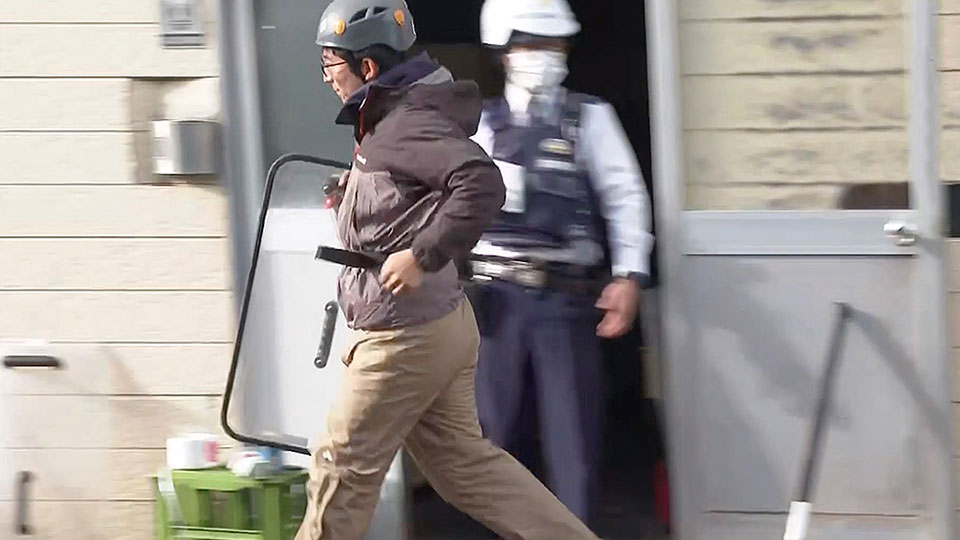The Environment Ministry says there were 219 victims in fiscal 2023, which ended in March. Incidents were recorded in 19 of Japan's 47 prefectures.
In one recent case, a bear appeared near the stockroom of a restaurant in Fukuchiyama City, Kyoto Prefecture earlier this month. The restaurant was open when the bear was spotted and police were called. But there were no injuries as all the customers and employees remained inside the restaurant.

On the same day, a bear in Iwate prefecture attacked a man in his 70s who was picking wild greens in the mountains of Kitakami City, injuring him.
Another prefecture that struggles with bear attacks is Akita, which had 70 people injured by bears in fiscal 2023, the worst ever.
Reported bear sightings have already hit 32 as of April this year, 1.5 times higher than in average years. As a result, the prefectural government issued a black bear warning on April 18, the earliest since it began such warnings in 2016.
"Urban bears" are increasing in Japan: https://www3.nhk.or.jp/nhkworld/en/news/backstories/2821/
Hokkaido: Hunt or protect?
In the northern prefecture of Hokkaido, bear sightings have occurred one after another in human communities, and 6 people have been killed in the past 3 years.
As a result, the prefectural government introduced a new system last year where hunters are allowed to enter the mountains in the early spring, after brown bears come out of hibernation, and actively hunt them.
This is just the latest twist in Hokkaido's history of handling brown bears, which has swung between protection and extermination.
From the 1960s on, it promoted extermination, leading to such a sharp drop in numbers that experts once warned the species was at risk of extinction.

The government reversed itself in 1990, moving to a more protective stance. But in the more than 30 years since, the number of bears has doubled, prompting them to take strong measures again.
But many local governments in Hokkaido are unable to start full-scale hunting after the 30-year gap, which resulted in a shortage of qualified, experienced hunters.
Obihiro City, with a population of about 160,000, is one example. A city official said that only a small number of members of a hunting club had actual experience of hunting to kill, and it is not something that can be easily done right away.
Why is it difficult to hunt brown bears?
Brown bears are said to be very cautious and have a sense of smell several times that of dogs, making it difficult to find them in the mountains. Also, since the animals can run at a speed of 60 kilometers per hour, it is necessary to have a shooting technique that allows hunters to approach the bear without being caught and accurately hit a critical spot.
In addition, hunting in early spring requires techniques for climbing snowy mountains since snow may linger.
After Hokkaido banned the hunting of bears 30 years ago, there have been almost no cases of bears being taken by hunters in the mountains. Most of the bears captured in Hokkaido are from box traps.
Expert: Perfect safety is impossible
Tsuruga Hifumi at Hokkaido Research Organization, who is familiar with the ecology of bears, says it is important to take thorough measures to prevent people from encountering bears. The reason is that there is no guarantee of 100 percent safety if humans and bears meet.
He says it is important to check information on bear sightings issued by local governments before entering mountains, stay away from places where many bears appear and let bears know that people are present.
Tsuruga says that it is effective to carry bells and horns that can be purchased at outdoor goods stores. People in the mountains should sound them when they approach places with thick vegetation.
Backstop
No matter how cautious we might be, bears may suddenly appear.
When you are more than 50 meters away from a bear, don't run. Instead, back away carefully. Running and showing your back is bad, because bears will chase you instinctively.
If you encounter a bear at close range or come close to it, use a repellent spray made of red pepper and other ingredients. Spray the bear's eyes and nose, and escape to a safe place.
In the worst case, if you encounter a bear at extremely close range and don't have spray, lie face down and protect your neck, face and belly, then run away when the bear leaves. But this is strictly a last resort.
Here is a video NHK made under expert supervision on how to act when you meet a bear. https://www3.nhk.or.jp/nhkworld/en/news/backstories/2731/
